Introduction
You must have come across or heard of the Merkle tree if you’ve been reading about blockchain technology. If not, there’s no problem; you’ll get to find out about it right away. The Merkle tree is one of the key ideas in computer science for creating a secure, decentralized network.
But what exactly is a Merkle tree? How is it utilized by Blockchain? Does it also utilize Bitcoin and Ethereum? The post that follows answers all the aforementioned queries and provides extra information.
Now let’s start by comprehending why the Merkle tree is necessary.
As is common knowledge, each member of a decentralized network like a blockchain receives a copy of the data. As opposed to a centralized network, which retains a single copy of all records.
Yet, consistent validation and data integrity are required for disseminating the same copy of the modified information. The Merkle tree aids in maintaining the network’s consistency and integration by organizing hashes.
What is Merkle Tree
The Merkle tree is a data structure that is used to efficiently and securely encrypt transactions. It is made up of hashes of various transaction data blocks. In a nutshell, it serves as a transaction summary for a block in a blockchain network.
- A Merkle Tree’s structure is a hierarchical way of representing transaction hashes.
- Merkle Root (or Root Hash): The tree’s top node.
- Nodes that do not have a leaf: Transaction hash nodes in between Leaf Nodes: Transactions nodes or child nodes
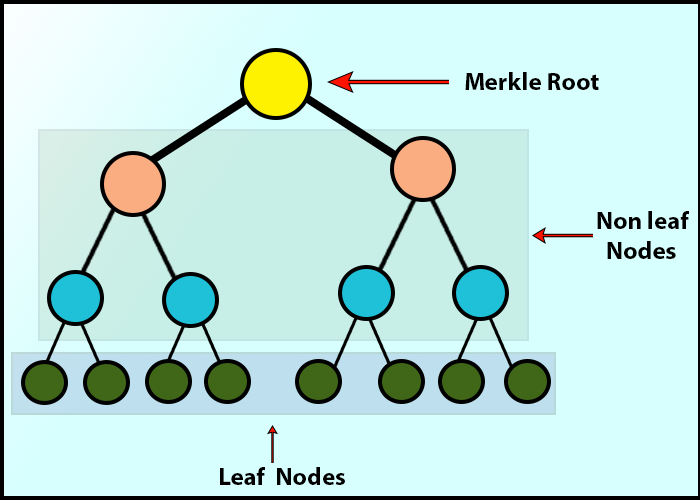
How does Merkle Tree work
Merkle tree encrypts and verifies network transactions using the concepts of cryptographic hash functions and public-key cryptography.
Merkle trees are constructed by hashing pairs of nodes until only one hash remains, known as the Root Hash or Merkle Root. It is constructed from the ground up using transaction IDs, which are hashes of individual transactions. It generates a digest or hash of the transactions using cryptographic hash functions.
Each non-leaf node in the Merkle tree structure is a hash of its previous hash. And each leaf node is the hash of each block’s transactional data.
Let’s wrap up the Merkle tree’s operation with the diagram below.
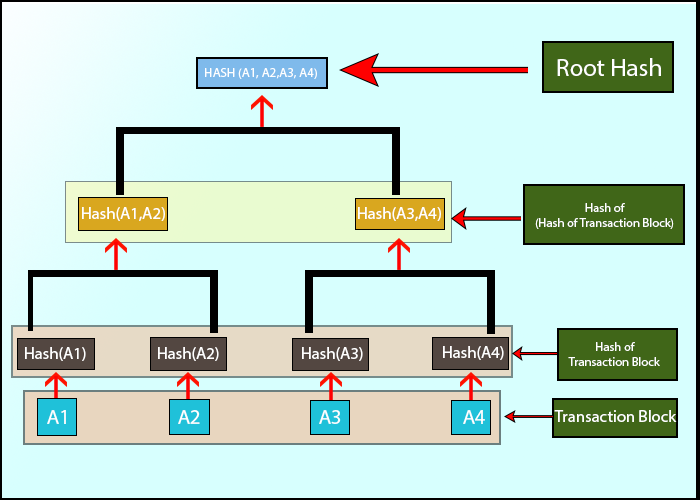
The steps are as follows:
- Each transaction in a block is individually hashed using cryptographic hash functions such as SHA-256.
- Hierarchical hashing occurs, with hashes of hashed transactions created using hash functions.
- The hashing process is repeated until we obtain a Root Hash or Merkle Root.
How is Merkle Tree useful in blockchain?
A chain of blocks is referred to as a “blockchain”. Each block has a set of information or components in the block header, including the block hash, previous block hash, nonce, difficulty, and many more. The Merkle root is one of them.
A sort of summary of all the transactions in a block is called a Merkle root. That will be evident in the Merkle tree’s data integrity. The network participants can confirm the transactions haven’t been altered by using Merkle root.
The chain image in your thoughts can be made clearer by the diagram below.
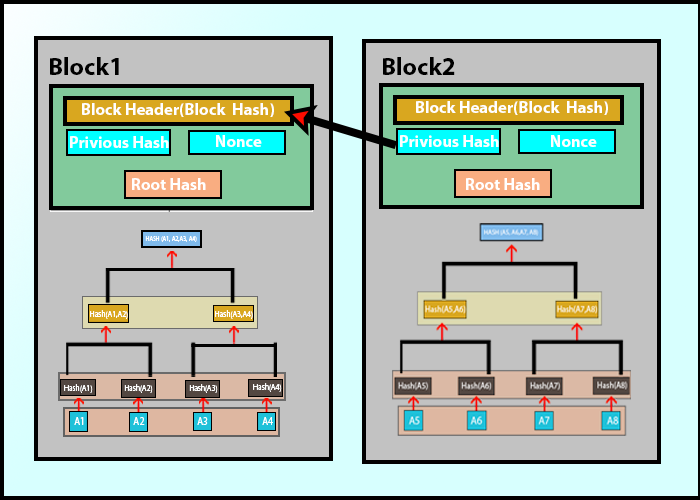
The Merkle tree approach is used by Bitcoin to maintain the integration of transaction blocks. Verified and integrated have been used frequently in the paper you just read. Let’s explain it through an example. An example of Data Integrity using Merkle Tree
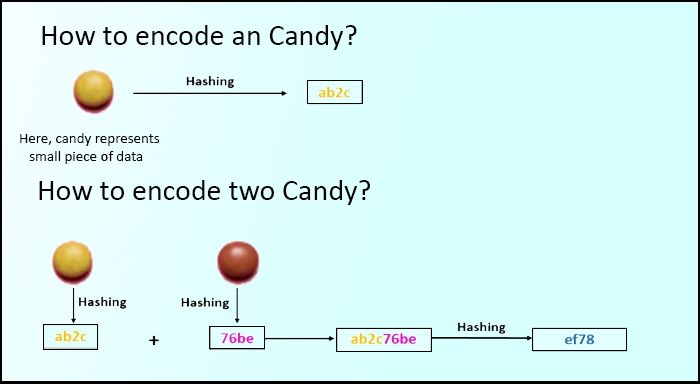
Now, compare Merkle tree encryption of information to standard encryption of information.
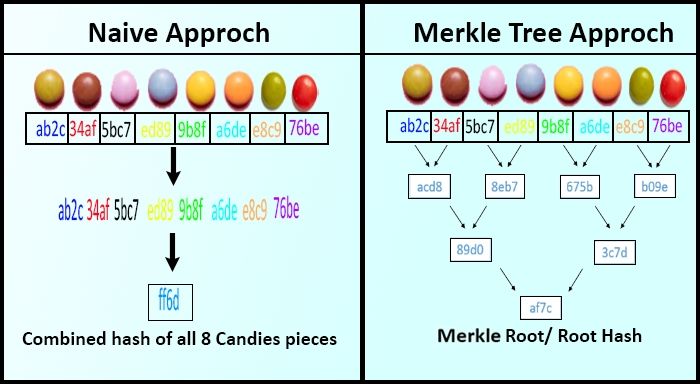
Now, compare Merkle tree encryption of information to standard encryption of information.
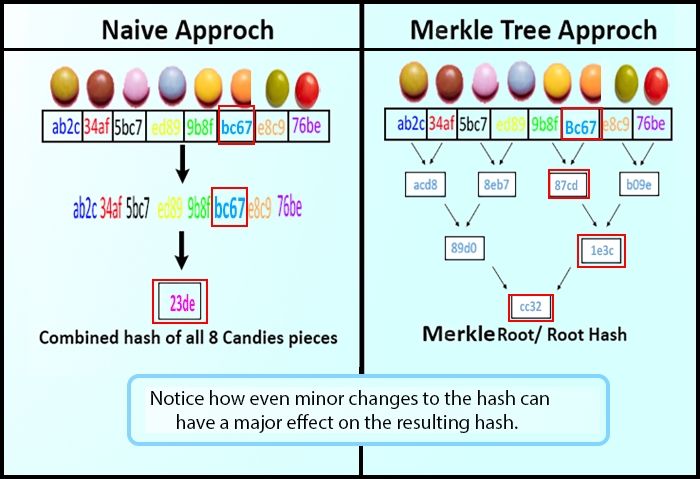
How can you be sure the data portion was corrupted?
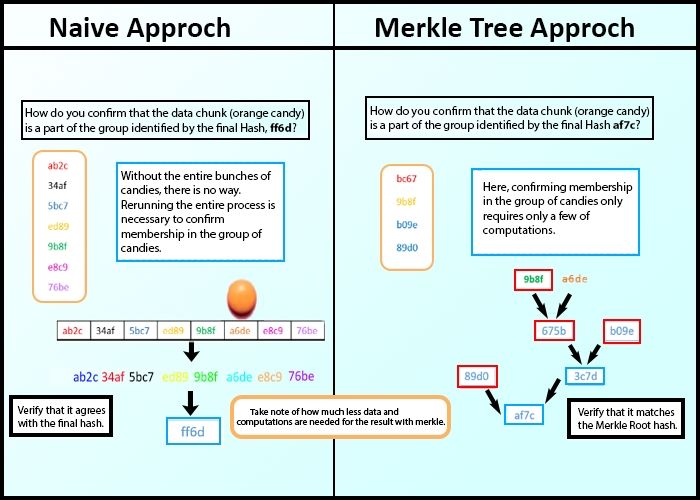
We saw how cryptography works using the Merkle tree in the preceding example. That is also consistent with the hash integration. Even little changes to the data significantly impact the final hash. Yet, mapping cryptography with a tree data structure makes identification and verification easy.
Merkle Tree Benefits
The Merkle tree has the following advantages:
- Verification efficiency: Verifying vast volumes of data efficiently is one of Merkle Trees’ main advantages. By traversing the Merkle Tree, a user can easily verify a small subset of the data they are interested in without having to verify the complete data set. Time and computer resources may be saved in this way.
- Security: By allowing users to confirm that a single piece of data is part of a bigger data set without disclosing any additional information about the data set, Merkle Trees offer a high level of security. This is helpful in circumstances when data security and privacy are crucial, such as in blockchain applications and scenarios involving cryptocurrencies.
- Scalability: Merkle Trees can be used to quickly and efficiently check massive volumes of data due to their high level of scalability. This is especially helpful in distributed systems where nodes could only have a few resources.
Merkle Tree Use Cases
Other than blockchain, the Merkle tree can be used in the following ways:
- Cryptocurrencies: To guarantee the security and integrity of transactions, Merkle Trees are employed in blockchain-based cryptocurrencies like Bitcoin. The Merkle Tree seen in every block of the Bitcoin blockchain allows nodes to validate transactions without downloading and validating the full blockchain.
- Digital Signatures: The integrity and authenticity of documents are guaranteed by the use of Merkle Trees in digital signatures. Since a document was signed, a user can use a Merkle Tree to verify that it has not been tampered with.
- Merkle Trees can be used in decentralized applications (DApps) to allow users to validate data and transactions without needing to believe in a central authority. This might aid in ensuring the application’s dependability and security.
Conclusion
The Merkle tree and how it works are explained in the above article. It also explained how data in a Merkle tree structure is verified. Also, it discusses how Bitcoin uses the Merkle tree, as well as its benefits and additional cases.
We hope you enjoyed learning about the Merkle tree with us.
FAQs
Q. How do Merkle Trees function in a blockchain?
A. A Merkle Tree in blockchain is a tree of hashes, where each leaf node represents a block or transaction and each parent node represents the hash of its two children. The hash of all the transactions in the block is represented by the root node of the tree.
Q. What are the advantages of a Merkle Tree in blockchain?
A. Users can use Merkle Trees to validate transactions and data without having to download and validate the entire blockchain. Time and computing resources may be saved in this way.
Q. Can Merkle Trees be used for purposes other than blockchain?
A. A wide range of applications where data integrity and security are crucial can use Merkle Trees, so the answer is yes.
Q. Are Merkle Trees always used in blockchain technology?
A. Merkle Trees are not just used in blockchain; they can also be used in other distributed systems where data security and integrity are crucial. They are, however, frequently used in blockchain due to their effectiveness and scalability in verifying massive amounts of data.
Q. Are Merkle Trees subject to any limitations?
A. Since updating a Merkle Tree necessitates rebuilding the entire tree, it is not recommended for situations where frequent updates to the data set are needed. Merkle Trees are also susceptible to some attacks, such as collision attacks, which can jeopardize the tree’s security. But by utilizing other cryptographic methods and best practices, these restrictions can be overcome.











